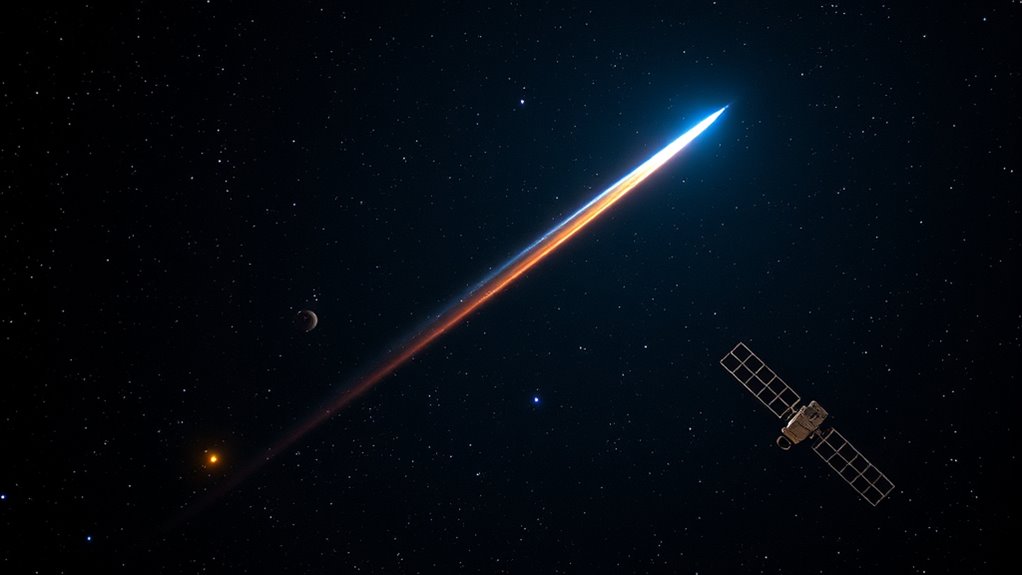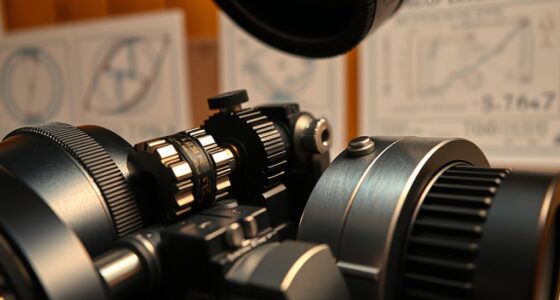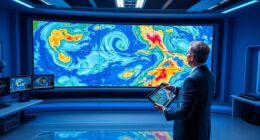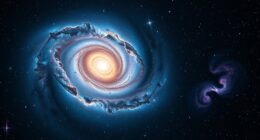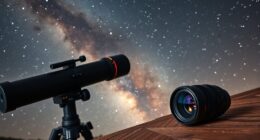To track solar-system objects like comets, asteroids, and satellites, you rely on precise observations using calibrated telescopes that correct for distortions and atmospheric effects. Applying orbital mechanics helps you predict their future positions with accuracy. Continuous data collection and model updates are essential for tracking fast-moving objects and evaluating potential risks. If you keep exploring, you’ll discover more about the fascinating methods used to monitor our ever-moving celestial neighborhood.
Key Takeaways
- Orbital mechanics enable prediction of a comet, asteroid, or satellite’s position at any given time.
- Telescope calibration ensures accurate measurements vital for tracking small, fast-moving objects.
- Precise data collection and measurement are essential for monitoring object trajectories in space.
- Orbital models incorporate observations to forecast future positions and potential hazards.
- Continuous observation and recalibration maintain the accuracy of tracking and understanding solar-system objects.
Have you ever wondered how astronomers keep track of planets, asteroids, and comets as they move across our solar system? It all begins with understanding orbital mechanics, the science that explains how celestial bodies travel along their paths around the Sun. By applying the principles of orbital mechanics, astronomers can predict where an object will be at any given time, which is essential for tracking fast-moving comets or tiny asteroids that might pose a threat to Earth. But to do this accurately, they need precise observations, and that’s where telescope calibration becomes vital. Proper calibration ensures that the images and data collected are reliable, free from distortions or errors caused by the equipment itself. When a telescope is well-calibrated, it can detect subtle changes in an object’s position, allowing astronomers to refine their calculations and improve their predictive models.
Using powerful telescopes, astronomers observe these objects against the backdrop of stars, measuring their positions with incredible precision. These measurements are then fed into complex computer models based on orbital mechanics, which help determine the objects’ trajectories. Calibration plays a crucial role here; if a telescope isn’t properly calibrated, the positional data could be off, leading to inaccuracies in tracking. For example, slight misalignments or optical distortions can cause an object’s apparent position to shift, making it seem like it’s moving differently than it really is. By regularly calibrating their telescopes—adjusting for things like atmospheric interference, instrumental drift, or optical imperfections—astronomers ensure their data remains accurate and reliable.
Once the initial data collection is complete, astronomers use orbital mechanics to analyze the object’s motion, predicting future positions and potential interactions with other bodies. This process is especially important for tracking near-Earth objects (NEOs), which could someday become hazardous. Continuous observation and recalibration mean that their predicted paths stay updated, giving scientists the best chance to assess risks or plan future missions. This combination of precise measurements, rigorous calibration, and sophisticated modeling forms the backbone of tracking solar-system objects. It’s a meticulous process that requires attention to detail and understanding of physics, but it’s essential for keeping tabs on the dynamic dance of planets, asteroids, comets, and satellites across our celestial neighborhood.
Frequently Asked Questions
How Do Solar-System Objects Affect Earth’s Climate?
You might not realize it, but solar-system objects can influence Earth’s climate by affecting solar radiation and atmospheric aerosols. For example, large asteroid impacts or comet fragments can inject aerosols into the atmosphere, reflecting sunlight and causing cooling. Additionally, variations in solar radiation from solar system dynamics can alter climate patterns. These effects demonstrate how celestial events play a role in shaping Earth’s climate over time.
Can Tracking Data Predict Asteroid Impacts Accurately?
Yes, tracking data can predict asteroid impacts accurately. You rely on impact prediction methods that use orbit modeling to forecast potential collisions. Precise observations help refine asteroid trajectories, allowing you to assess impact risks over time. While predictions become more reliable with better data, uncertainties still exist, especially for long-term forecasts. Continuous monitoring and advanced modeling are essential for improving impact predictions and ensuring planetary safety.
What Are the Latest Technologies Used in Tracking Satellites?
Imagine trying to find a needle in a haystack—that’s what satellite tracking feels like. Today, space surveillance uses advanced radar, laser ranging, and high-resolution telescopes to monitor satellites precisely. Technologies like phased-array radars and AI-enhanced algorithms improve accuracy and real-time tracking, helping us keep tabs on thousands of objects orbiting Earth. These innovations are essential for collision avoidance and ensuring the safety of space operations.
How Do Scientists Distinguish Between Natural and Artificial Objects?
You can distinguish natural from artificial objects using identification techniques like analyzing their orbit, shape, and reflectivity. Natural objects, like comets and asteroids, usually follow predictable paths and have irregular shapes, while artificial satellites often have specific orbital patterns and smooth surfaces. By studying their motion, brightness, and spectral signatures, scientists can accurately identify whether an object is natural or artificial in origin.
What Role Do Amateur Astronomers Play in Tracking Solar-System Objects?
You might think amateur observations don’t matter, but your visual tracking plays a crucial role in solar-system studies. Amateur astronomers often discover new objects or help track known ones, providing valuable data that complements professional efforts. Your dedication to observing and recording helps scientists monitor comets, asteroids, and satellites, ensuring we stay updated on their movements and potential impacts, making your contributions vital to planetary defense and space research.
Conclusion
Tracking solar-system objects helps you understand our cosmic neighborhood better. Did you know that over 1 million asteroids are larger than 1 kilometer in diameter, with thousands tracked regularly? By monitoring comets, asteroids, and satellites, you can appreciate how dynamic and ever-changing our solar system is. Staying informed not only sparks curiosity but also helps protect Earth from potential impacts. Keep exploring the skies—there’s always more to discover beyond our planet!
